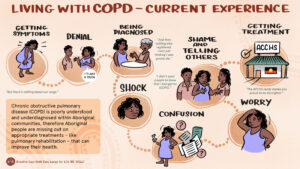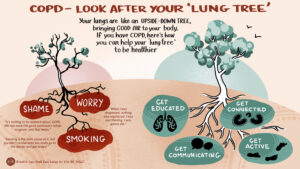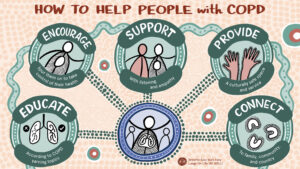The following illustrations are based on what Aboriginal and/or Torres Strait Islander peoples expressed in experience of care interviews about living with COPD¹.
These resources could help health professionals understand Aboriginal and/or Torres Strait Islander people’s points of view and inform conversations with patients.
1. Living with COPD – Current Experience
- Getting symptoms: Aboriginal and/or Torres Strait Islander peoples may have limited knowledge about COPD and often think the symptoms of breathlessness and cough are a normal part of ageing. They also may not know that there are things that can help them to live well with COPD.
- Being diagnosed and shock: When Aboriginal and/or Torres Strait Islander peoples get a diagnosis of COPD (or emphysema), many think they will die because that is what they have seen happen to their relatives.
- Confusion: They may be confused about all the new information and medications (such as inhalers).
- Worry and shame: They may be worried and feel ‘shame’ about how COPD may change their relationships with family and friends. They may need support on how to talk with their family, friends and community about COPD. They may need support to know that COPD is manageable, and that things can be done to reduce symptoms and live well with COPD.
2. Living with COPD – Opportunities
- Better understanding: When Aboriginal and/or Torres Strait people understand COPD better and know how to live well with COPD, it may be easier to see a doctor earlier and not feel so worried about telling others.
- ACCHSs at the centre of culturally safe care: Going to the local ACCHS will help those with COPD to make sure they are on the most effective medications, can exercise at local pulmonary rehabilitation classes (if it is available), and connect with other Aboriginal and/or Torres Strait Islander peoples living with COPD in a culturally safe environment.
3. Looking after your ‘Lung Tree’
When talking with Aboriginal and/or Torres Strait Islander peoples about their lungs, look for ways to connect the environment (as metaphors) to explain how the lungs work.
As a health professional you may like to explain to people with COPD how the lungs are like an upside-down tree:
‘The lungs are like an upside-down tree bringing air into your lungs along the branches (airways) so that oxygen can get to the leaves (air sacs) where in gets into the blood and is taken around your body to where it is needed’.
The illustration on the left is about Shame, Worry & Smoking. It is what Aboriginal and/or Torres Strait Islander people with COPD said after they learnt more about COPD. They reflected that although they felt Shame when they were diagnosed with COPD, they now realise that there are opportunities to manage COPD and that many people in their community have the disease.
People also reported that if they had knowledge about COPD and good management when they first experienced symptoms, they would not have worried (Worry) as much and would know that a COPD diagnosis is not a death sentence. Until Aboriginal and/or Torres Strait Islander peoples were tested with spirometry, they didn’t realise how much Smoking had affected their lungs (see quotes in the illustration).
As a health professional, encourage Aboriginal and/or Torres Strait Islander communities to ‘look after your lung tree’. The messages are:
- get educated about COPD and what can be done to live well with the disease,
- get communicating with others especially the health professionals in the ACCHS,
- get active – we know that being physically active and exercise training programs (pulmonary rehabilitation) can really improve the quality of life of people with COPD and help prevent hospitalisation,
- get connected with culture and family and friends which improves well-being.
4. How Health Professionals Can Help People with COPD
The Aboriginal and/or Torres Strait Islander person living with COPD is at the centre of this illustration. As health professionals, to help people with COPD you can:
- provide education according to the COPD yarning topics,
- encourage people with COPD to take control of their health, for example to quit smoking, start exercising, know how to use inhalers, have an action plan, healthy eating etc.
- refer the person with COPD to a pulmonary rehabilitation program
- provide support through taking time to listen to the person with COPD and help them on their health journey with empathy.
- engage your local Aboriginal and/or Torres Strait Islander health team or health worker (if you work in a local health district) to provide a culturally safe space and service and/or refer to the local ACCHS or work in partnership with the ACCHS,
- encourage the person with COPD to stay connected with family, community and country.
References:
- Meharg DP, Dennis SM, McNab J, Gwynne KG, Jenkins CR, Maguire GP, Jan S, Shaw T, McKeough Z, Rambaldini B, Lee V, McCowen D, Newman J, Monaghan S, Longbottom H, Eades SJ, Alison JA. A qualitative study of Aboriginal peoples’ health care experiences with chronic obstructive pulmonary disease. Qualitative Health Research. 2025 Feb;35(2):216-233: https://doi.org/10.1177/10497323241259891
- Meharg DP, Dennis SM, McNab J, Gwynne KG, Jenkins CR, Maguire GP, Jan S, Shaw T, McKeough Z, Rambaldini B, Lee V, McCowen D, Newman J, Monaghan S, Longbottom H, Eades SJ, Alison JA (2023). A mixed methods study of Aboriginal health workers’ and exercise physiologists’ experiences of co-designing chronic lung disease ‘yarning’ education resources. BMC Public Health 23(1): 612. DOI: 10.1186/s12889-023-15508-y






